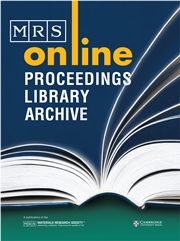No CrossRef data available.
Article contents
Modeled Near-Field Environment Porosity Modification due to Coupled Thermohydrologic and Geochemical Processes
Published online by Cambridge University Press: 10 February 2011
Abstract
Heat generated by waste packages in nuclear waste repositories can modify rock properties by instigating mineral dissolution and precipitation along hydrothermal flow pathways. Modeling this reactive transport requires coupling fluid flow to permeability changes resulting from dissolution and precipitation. Modification of the NUFT thermohydrologic (TH) code package to account for this coupling in a simplified geochemical system has been used to model the timedependent change in porosity, permeability, matrix and fracture saturation, and temperature in the vicinity of waste-emplacement drifts, using conditions anticipated for the potential Yucca Mountain repository. The results show dramatic porosity reduction approximately 10 m above emplacement drifts within a few hundred years. Most of this reduction is attributed to deposition of solute load at the boiling front, although some of it also results from decreasing temperature along the flow path. The actual distribution of the nearly sealed region is sensitive to the time-dependent characteristics of the thermal load imposed on the environment and suggests that the geometry of the sealed region can be engineered by managing the waste-emplacement strategy and schedule.
- Type
- Research Article
- Information
- Copyright
- Copyright © Materials Research Society 1999


